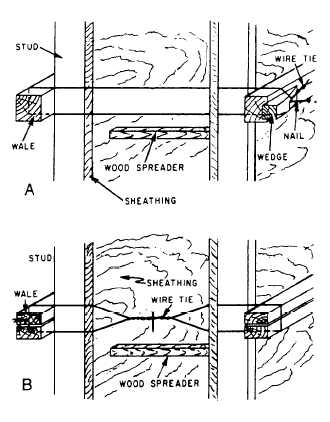form reuse. Some of the elements wooden forms are sheathing, studs, shoe plates, spreaders, and tie wires. that make up wales, braces,
CONSTRUCTION. - Sheathing forms the surfaces of the concrete. It should be as smooth as possible, especially if the finished surfaces are to be exposed. Since the concrete is in a plastic state when placed in the form, the sheathing should be watertight. Tongue-and-groove sheathing gives a smooth, watertight surface. Plywood or hardboard can also be used and is the most widely accepted construction method.
The weight of the plastic concrete causes sheathing to bulge if it is not reinforced. As a result, studs are run vertically to add rigidity to the wall form. Studs are generally made from 2-by-4 or 3-by-6 material.
Studs also require reinforcing when they extend over 4 or 5 feet. This reinforcing is supplied by double wales. Double wales also serve to tie prefabricated panels together and keep them in a straight line. They run horizontally and are lapped at the corners of the forms to add rigidty. Wales are usually made of the same material as the studs.
The shoe plate is nailed into the foundation or footing. It is carefully placed to maintain the correct wall dimension and alignment. The studs are tied into the shoe and spaced according to the correct design.
Small pieces of wood are cut the same length as the thickness of the wall and are placed between the forms to maintain proper distance between forms. These pieces are known as spreaders. The spreaders are not nailed but are held in place by friction and must be removed before the concrete covers them. A wire should be securely attached to each spreader so that the spreaders can be pulled out after the concrete has exerted enough pressure on the walls to allow them to be easily removed.
lie wire is designed to hold the forms securely against the lateral pressure of unhardened concrete. A double strand of tie wire is always used.
BRACING. - Many types of braces can be used to add stability and bracing to the forms. The most common type is a diagonal member and horizontal member nailed to a stake and to a stud or wale, as shown in figure 7-8. The diagonal member should make a 30° angle with the horizontal member. Additional bracing may be added to the form by placing vertical members (strongbacks) behind the wiles or by placing vertical members in the corner formed by intersecting wales. Braces are not part of the form design and are not considered as providing any additional strength.
REINFORCEMENT. - Wall forms are usually reinforced against displacement by the use of ties. Two types of simple wire ties, used with wood spreaders, are shown in figure 7-9. The wire is passed around the studs, the wales, and through small holes bored in the sheathing. Each spreader is placed as close as possible to the studs, and the tie is set taut by the wedge, as shown in view A of figure 7-9, or by twisting with a small toggle, as shown in view B. As the concrete reaches the level of each spreader, the spreader is knocked out and removed. Figure 7-10 shows you an easy way to remove the spreaders by drilling holes and placing a wire through them. The parts of the wire that are inside the forms remain in the concrete; the outside surplus is cut off after the forms are removed.

Figure 7-9.-Wire ties for wall forms.
Continue Reading